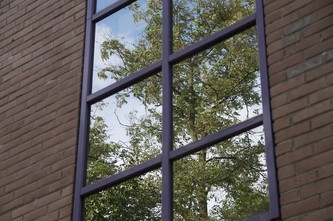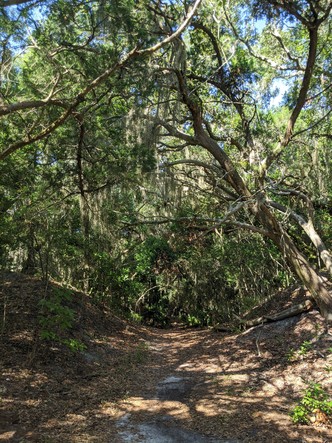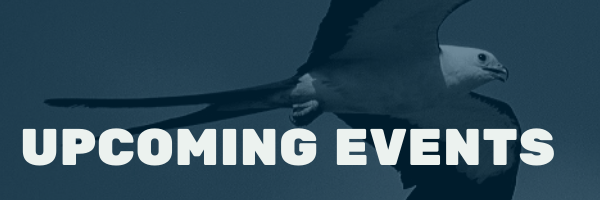 When windows reflect their surroundings, birds perceive them as more outdoor space, increasing the chance of collisions.
Fall migration is well underway, bringing scores of birds through the Florida peninsula on their way south. It’s an exciting time to be a birder, as we see fall warblers in the branches, an abundance of shorebirds refueling on our beaches and raptors soaring overhead. Their long journeys are an incredible phenomenon – one that requires a lot of energy and can be a particularly stressful part of the year for them.
When birds are exhausted and on the move, some of the threats they face become even more intense. Window collisions are one such threat that sees an uptick during migration season. Collisions with glass pose a major threat to bird populations and are estimated to kill up to a billion birds each year.
Birds can’t use the context clues that we do to understand that a glass barrier is present. When we see a window frame or a sliding glass door, we know that we can’t pass through because we are familiar with these objects. A bird will see one of two things when looking at a window, depending on the light conditions. They could see inside or could be seeing the reflection of the surrounding landscape. For birds to steer clear, they need visible markers, preferably on the outside of windows, that make the barrier obvious.
If you are noticing collisions around your home, the good news is that there are plenty of ways to let birds know they can’t fly through – and these solutions don’t have to ruin your view.
- Use tape or tempera paint to create patterns or designs on the outside of your windows.
- Use screens, netting or hanging string curtains over windows to break up reflections.
- Place decals on your windows. It doesn’t matter what shape these decals are – hawk silhouette decals don’t actually prevent collisions more than other shapes, so choose whatever you would like. The important thing is that decals be close enough together. Experts recommend they be spaced no more than every 4 inches horizontally and 2 inches apart vertically.
Just a few simple changes can remove an obstacle for our feathered friends as they make their journey southward – keeping them safe so we can see them again next spring. For more information and examples of bird-safe windows, check out the extensive resources from the American Bird Conservancy.
 Oaks shade paths traversing ancient dunes at Fort Clinch State Park.
Fort Clinch State Park in Fernandina Beach is the northernmost gateway site on the Great Florida Birding and Wildlife Trail. This park offers a variety of bird species and habitats – from maritime hammocks to salt marshes, and from coastal strand to beaches and ocean. Over 250 species have been recorded here, including over 25 species of wood warbler. Check alongside the entrance road for woodpeckers, warblers, and sparrows, and walk the fishing pier alongside the rock jetty to see a plethora of coastal species.
 Sandy beaches are excellent for spotting shorebirds.
There is plenty to explore at Fort Clinch State Park – six miles of trails wind through the park for hikers to explore the forest and beaches, and the paved 3-mile main drive is excellent for bicycling. The park is also an excellent spot for fishing or lounging on the beach, and 69 campsites are available for those who want to extend their stay. The fort itself also has a fascinating history and Civil War buffs will enjoy exploring this historic landmark.
Address: 2601 Atlantic Ave, Fernandina Beach, FL 32034
Hours: 8 a.m. to sundown, 365 days per year. Fort is open daily from 9 a.m. - 5 p.m.
Contact: 904-277-7274
Admission: $6/vehicle for park admission, $2.50/person for fort admission

October 11 – Field Trip to Three Lakes Wildlife Management Area (Kenansville)
October 14 – What’s Going on at the Welaka National Fish Hatchery (Webinar)
October 17 – Hernando Audubon Birding Trip to Perry Oldenburg (Brookesville)
October 19 – Jacksonville Arboretum and Gardens: A Look into Future Plans (Webinar)
October 22 – The Environmental Value of Weeki Wachee Springs State Park (Webinar)
October 23 – Hernando Audubon Beginning Birding (Brookesville)
October 24 – Open House at Crosby Sanctuary (Orange Park)
October 31 – Hernando Audubon Birding Trip to Ahhochee Hill Sanctuary (Brooksville)
Check out the events page of our website for more events across the state!
Do you know about any other bird or wildlife-related events going on in Florida? Help spread the word by letting us know! Send in the times, dates, locations and contacts to WildlifeViewing@MyFWC.com for posting on the Great Florida Birding and Wildlife Trail website.
Events must be related to birds or other wildlife and must be open to the public. Examples include interpretive programming, summer camps and family programs.
|